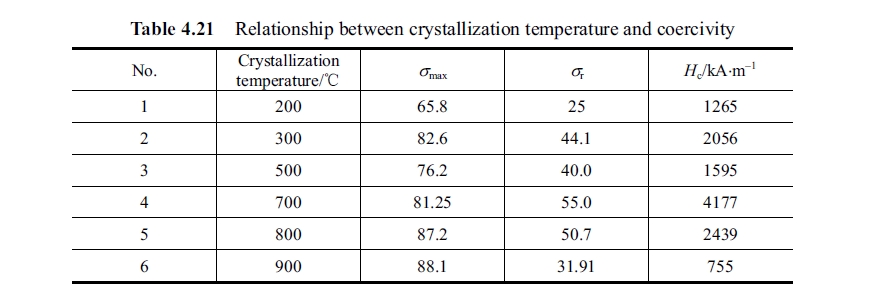4.12 Quick-Quenched NdFeB Permanent Magnetic Alloy: Structure and Magnetic Properties
This section introduce the following study project: (1) use cheap Nd - Pr rare earth metal compound as raw material to reduce material cost; (2) seek for temperature and program to change non - crystal to microcrystal; (3) use 1000 kV HVM to conduct dynamic observation and achieve fruition.
Sample Preparation Techniques and Experimental Methods for Quick-Quenched NdFeB Alloys
Inconsumable arc furnace was used to melt alloys of \((Nd, Pr)_{12.5}Fe_{83}B_{4.5}\), \((Nd, Pr)_{13.5}Fe_{80}B_{6.5}\), \((Nd, Pr)_{14.5}Fe_{96.5}\) and \(Nd_{13.5}Fe_{82.5}\). Composition of raw material (wt) is: \((Nd, Pr)\) mix rare earth metal: Nd 94.22%, Pr 3.68%, La 0.33%, Ce 0.32%; metallic Nd: 99.69%, Pr 0.1%, Sm 0.05%, Ce 0.07%, La 0.09%; Fe 99.8%; B: used BFe alloy with B 18.7%. In melting process draw vacuum at first, then refill argon gas for protection, to ensure homogeneous turning over repeatedly and use good water - cooling condition to obtain good columnar crystal. Afterwards, use single - roller method to quench anneal alloy thin belt in high purity argon. Surface speed of copper roller was 30 m/s, belt width was \(2 - 3\) mm, thickness of flinty belt was 20 - 30 μm. Annealing was conducted at \(4\times10^{5}\) Pa in vacuum heat treatment furnace. Quick quenched sample was identified as non - crystalline state by means of X - ray diffraction and heat treatment temperature of quick quenched sample for crystallizing was 705 - 710°C. Comminuted magnetic powder was bond by epoxy resin and was press - molded. Observation was carried out by JEM - 1000 HVM at room temperature and high temperature: sample film was enclosed into JEM - 1000 side - insert heating dais, voltage was 1000 kV, and vacuum degree was \(266\times10^{-5}\) Pa (Pan, Ping, Liu, et al, 2003; Liu, Pan, Luo, 1991).
Magnetic Property Measurements of Quick-Quenched NdFeB Magnets
It can be seen that using cheap \((Nd, Pr)\) rear earth mixing metal as raw material to produce quick quenched magnet is feasible, the magnetic performance of magnet made of \((Nd, Pr)\) was almost the same as that made of pure neodymium (Table 4.20). Thereby production cost of the NdFeB magnet can be reduced considerably.

Crystallization Temperature vs. Coercivity in Quick-Quenched NdFeB Magnets
It can be seen from Table 4.21 that crystallization is good at \(700^{\circ}C\) for short time, of which mechanism can be understood as: at low temperature energy for nucleation is inadequate and hereupon presents as growing up of original crystals; if at high temperature new heat activation causes that difference in free enthalpy between old and new phases is below zero, and thus phase transformation occurs spontaneously, and driving force of nucleation is generated to make uncrystallized part nucleated generally. That result in formation of micro - crystals.

Microstructure of Quick-Quenched NdFeB Alloy at Room Temperature
Quick quenched NdFeB alloy and sintered NdFeB alloy have different micro - structures. B - rich phase was not observed but in \(Nd_{2}Fe_{14}B\) phase internal structure of crystal granules was found to be integral in quick quenched NdFeB alloy by transmission microscope, the neighboring crystal interface was also found to be integrated, thus the alloy presented \(Nd_{2}Fe_{14}B\) single phase with equiaxed fine granules texture.
In-Situ HVEM Observation of Amorphous to Microcrystalline Transition in NdFeB Alloys
Non - crystalline sample after quick quenching, i.e., the sample without micro - crystals, was selected and was prepared to be film by the method aforementioned for observation by transmission electronic microscope. The observation by elec-tronic microscope was to observe the process of precipitation and growth of crys-tals. There was not any change of the sample to be found in observation from room temperature to \(400^{\circ}C\), and observation result indicated that the microstructure was still noncrystalline from diffraction of selected area under electronic microscope. But at \(420^{\circ}C\) the observation found that tiny crystals formed in the area originally having no precipitates, that indicated that microcrystals (crystallite) appeared. When raising temperature from \(420^{\circ}C\) to \(600^{\circ}C\) the observation found that the microcrystals grew up gradually and became crystals at \(600 - 700^{\circ}C\) referring to diffraction of the original selected area, that there was no non - crystalline area indicated that the sample became crystallized completely.
Conclusions: Performance and Structural Evolution of Quick-Quenched NdFeB Magnets
Result of magnetic measurement indicated that the magnetic performance bond magnet, made of quick quenched magnetic material with \((Nd, Pr)\) mixing rare earth metals to prepare, was equivalent to that of quick quenched magnet made of ternary NdFeB alloy, that can reduce price of magnet considerably because the price of \((Nd, Pr)\) mixing rare earth metals is cheaper than that of pure neodymium.
The experiment discovered that heat treatment at \(700^{\circ}C\) can heighten coercivity of quick quenched magnet considerably.
Dynamic observation found by 1000 kV HVM that microcrystals appeared in quick quenched non - crystalline sample at \(420^{\circ}C\), turned to be crystals completely at \(600 - 700^{\circ}C\), and that there was no non - crystals area indicated the transfer was completed.
Studies indicated that quenching speed (cooling speed) in quick quenching has important influence on magnetic performance of magnet. For alloy of composition \(Nd_{13.5 - 1.8}Fe_{83.5 - 6}B_{3.5 - 6}Fe_{6}\) quenching speed of quick quenching of \(20 - 30\)m/s is most appropriate. The quenching speed would be changed if alloy composition has big change.






